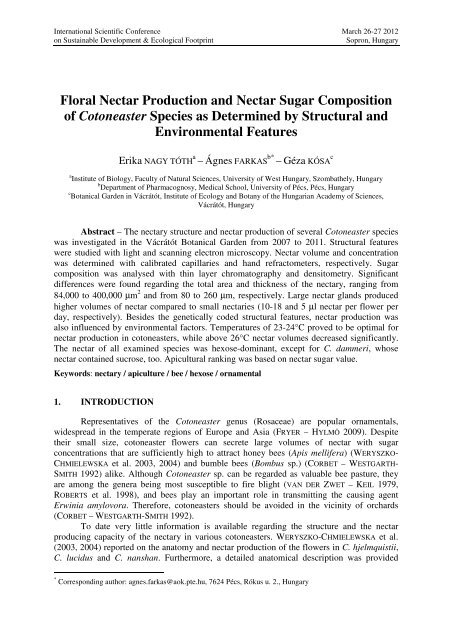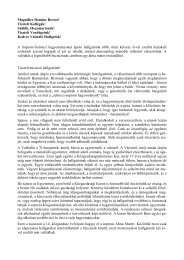Floral Nectar Production and Nectar Sugar Composition of ...
Floral Nectar Production and Nectar Sugar Composition of ...
Floral Nectar Production and Nectar Sugar Composition of ...
Create successful ePaper yourself
Turn your PDF publications into a flip-book with our unique Google optimized e-Paper software.
International Scientific Conference March 26-27 2012<br />
on Sustainable Development & Ecological Footprint Sopron, Hungary<br />
<strong>Floral</strong> <strong>Nectar</strong> <strong>Production</strong> <strong>and</strong> <strong>Nectar</strong> <strong>Sugar</strong> <strong>Composition</strong><br />
<strong>of</strong> Cotoneaster Species as Determined by Structural <strong>and</strong><br />
Environmental Features<br />
Erika NAGY TÓTH a – Ágnes FARKAS b* – Géza KÓSA c<br />
a Institute <strong>of</strong> Biology, Faculty <strong>of</strong> Natural Sciences, University <strong>of</strong> West Hungary, Szombathely, Hungary<br />
b Department <strong>of</strong> Pharmacognosy, Medical School, University <strong>of</strong> Pécs, Pécs, Hungary<br />
c Botanical Garden in Vácrátót, Institute <strong>of</strong> Ecology <strong>and</strong> Botany <strong>of</strong> the Hungarian Academy <strong>of</strong> Sciences,<br />
Vácrátót, Hungary<br />
Abstract – The nectary structure <strong>and</strong> nectar production <strong>of</strong> several Cotoneaster species<br />
was investigated in the Vácrátót Botanical Garden from 2007 to 2011. Structural features<br />
were studied with light <strong>and</strong> scanning electron microscopy. <strong>Nectar</strong> volume <strong>and</strong> concentration<br />
was determined with calibrated capillaries <strong>and</strong> h<strong>and</strong> refractometers, respectively. <strong>Sugar</strong><br />
composition was analysed with thin layer chromatography <strong>and</strong> densitometry. Significant<br />
differences were found regarding the total area <strong>and</strong> thickness <strong>of</strong> the nectary, ranging from<br />
84,000 to 400,000 µm 2 <strong>and</strong> from 80 to 260 µm, respectively. Large nectar gl<strong>and</strong>s produced<br />
higher volumes <strong>of</strong> nectar compared to small nectaries (10-18 <strong>and</strong> 5 µl nectar per flower per<br />
day, respectively). Besides the genetically coded structural features, nectar production was<br />
also influenced by environmental factors. Temperatures <strong>of</strong> 23-24°C proved to be optimal for<br />
nectar production in cotoneasters, while above 26°C nectar volumes decreased significantly.<br />
The nectar <strong>of</strong> all examined species was hexose-dominant, except for C. dammeri, whose<br />
nectar contained sucrose, too. Apicultural ranking was based on nectar sugar value.<br />
Keywords: nectary / apiculture / bee / hexose / ornamental<br />
1. INTRODUCTION<br />
Representatives <strong>of</strong> the Cotoneaster genus (Rosaceae) are popular ornamentals,<br />
widespread in the temperate regions <strong>of</strong> Europe <strong>and</strong> Asia (FRYER – HYLMÖ 2009). Despite<br />
their small size, cotoneaster flowers can secrete large volumes <strong>of</strong> nectar with sugar<br />
concentrations that are sufficiently high to attract honey bees (Apis mellifera) (WERYSZKO-<br />
CHMIELEWSKA et al. 2003, 2004) <strong>and</strong> bumble bees (Bombus sp.) (CORBET – WESTGARTH-<br />
SMITH 1992) alike. Although Cotoneaster sp. can be regarded as valuable bee pasture, they<br />
are among the genera being most susceptible to fire blight (VAN DER ZWET – KEIL 1979,<br />
ROBERTS et al. 1998), <strong>and</strong> bees play an important role in transmitting the causing agent<br />
Erwinia amylovora. Therefore, cotoneasters should be avoided in the vicinity <strong>of</strong> orchards<br />
(CORBET – WESTGARTH-SMITH 1992).<br />
To date very little information is available regarding the structure <strong>and</strong> the nectar<br />
producing capacity <strong>of</strong> the nectary in various cotoneasters. WERYSZKO-CHMIELEWSKA et al.<br />
(2003, 2004) reported on the anatomy <strong>and</strong> nectar production <strong>of</strong> the flowers in C. hjelmquistii,<br />
C. lucidus <strong>and</strong> C. nanshan. Furthermore, a detailed anatomical description was provided<br />
* Corresponding author: agnes.farkas@aok.pte.hu, 7624 Pécs, Rókus u. 2., Hungary
International Scientific Conference March 26-27 2012<br />
on Sustainable Development & Ecological Footprint Sopron, Hungary<br />
about the nectar gl<strong>and</strong>s <strong>of</strong> C. roseus in our previous paper (NAGY TÓTH et al. 2011). However,<br />
a larger number <strong>of</strong> Cotoneaster species should be investigated for at least two years to<br />
underst<strong>and</strong> the underlying factors regulating the nectar secretion process <strong>of</strong> cotoneasters. The<br />
varying nectar producing capacity <strong>of</strong> different species might be explained partly by the<br />
structural differences <strong>of</strong> their nectar gl<strong>and</strong>s, <strong>and</strong> partly by the actual environmental<br />
circumstances that will determine the volume <strong>and</strong> sugar concentration <strong>of</strong> the nectar produced<br />
by the flowers in the given year. In order to determine which factors are decisive for nectar<br />
production in cotoneasters, we investigated the nectary structure, as well as the sugar value<br />
<strong>and</strong> composition <strong>of</strong> the nectar in several Cotoneaster species in three years.<br />
2. MATERIALS AND METHODS<br />
2.1. Location <strong>and</strong> time <strong>of</strong> studies<br />
Field studies were carried out in the Vácrátót Botanical Garden in May <strong>and</strong> June <strong>of</strong><br />
2007, 2010 <strong>and</strong> 2011. Further investigations were performed in the appropriate laboratories <strong>of</strong><br />
the University <strong>of</strong> West Hungary <strong>and</strong> the University <strong>of</strong> Pécs.<br />
2.2. Studied species<br />
Investigations were performed on 13, 22 <strong>and</strong> 31 Cotoneaster species in 2007, 2010<br />
<strong>and</strong> 2011, respectively. For the detailed list <strong>of</strong> investigated species see Figure 5, 6 <strong>and</strong> 7 <strong>and</strong><br />
Table 1.<br />
2.3. Investigation <strong>of</strong> nectary structure<br />
2.3.1. Light microscopy<br />
Following dehydration in an ascending ethanol series, flowers were embedded in a<br />
hydroxyethyl methachrylate based resin (Technovit 7100). Medial longitudinal sections were<br />
cut with a rotary microtome (Anglia Scientific 325), stained with toluidine blue <strong>and</strong> mounted<br />
in Canada balsam. Slides were investigated with a NIKON ECLIPSE 80i microscope, <strong>and</strong><br />
micrographs were taken with SPOT BASIC 4.0. <strong>Nectar</strong>y area <strong>and</strong> thickness (at the thickest<br />
part <strong>of</strong> the gl<strong>and</strong>) were measured with Image Tool 3.0 in 10 <strong>and</strong> 20 flowers in 2007 <strong>and</strong> 2010,<br />
respectively. Data were analyzed with Micros<strong>of</strong>t Excel.<br />
2.3.2. Scanning electron microscopy<br />
Samples were prefixed in paraformaldehyde, washed in phosphate buffer, then<br />
postfixed in osmium tetroxide. Dehydration <strong>of</strong> samples in ascending ethanol series was<br />
followed by critical point drying in amyl acetate, <strong>and</strong> gold sputter coating. Micrographs were<br />
taken in the laboratory <strong>of</strong> the University <strong>of</strong> West Hungary with a HITACHI TM3000 type<br />
microscope.<br />
2.4. <strong>Nectar</strong> measurements<br />
2.4.1. 24-hour nectar measurements<br />
<strong>Nectar</strong> volume per flower was determined in the field with calibrated glass capillaries,<br />
following 24-hour isolation <strong>of</strong> the flowers by tulle nets, in order to exclude visiting insects.<br />
2
International Scientific Conference March 26-27 2012<br />
on Sustainable Development & Ecological Footprint Sopron, Hungary<br />
<strong>Sugar</strong> concentration was measured with a h<strong>and</strong> refractometer (ATAGO N-50E). <strong>Sugar</strong> value<br />
was calculated using the formula: nectar volume (µl) * nectar concentration (%)/100.<br />
2.4.2. <strong>Nectar</strong> sugar composition<br />
Dried nectar samples were taken up in 70% (v/v) ethanol. <strong>Sugar</strong> st<strong>and</strong>ards (sucrose, glucose,<br />
fructose; 1 mg/ml each) <strong>and</strong> nectar samples were applied to plates (Silica gel 60 F254, Merck)<br />
by microcaps. Plates were run twice in developing chambers without saturation. The mobile<br />
phase consisted <strong>of</strong> ethyl acetate : ethanol : 60% acetic acid : water coldly saturated with boric<br />
acid (50:20:10:10). Spots were visualised by dipping plates into a thymol-sulphuric acid<br />
reagent for 3 sec, then dried at room temperature, <strong>and</strong> finally at 105°C for 5 min.<br />
Densitometric evaluation was performed by a CAMAG TLC Scanner at 510 nm, using the<br />
s<strong>of</strong>tware CATS 3.14 for quantitative measurements.<br />
3. RESULTS<br />
3.1. Structural features <strong>of</strong> the nectary<br />
The floral nectary <strong>of</strong> cotoneasters is automorphic <strong>and</strong> receptacular, positioned between<br />
the ovary <strong>and</strong> the base <strong>of</strong> the stamens (Figure 1). The cuticle covering the nectary surface has<br />
an irregular ornamentation consisting <strong>of</strong> wrinkles <strong>and</strong> creases (Figure 2).<br />
stamen<br />
nectary<br />
Figure 1. <strong>Nectar</strong>y <strong>of</strong> Cotoneaster lancasteri<br />
<strong>Nectar</strong> is secreted through stomata, whose guard cells are either in level with the epidermal<br />
cells or slightly below the level <strong>of</strong> the epidermis (Figure 3). Subepidermally, 3 to 4 layers <strong>of</strong><br />
small, isodiametric cells comprise the gl<strong>and</strong>ular tissue; followed by the larger cells <strong>of</strong> nectary<br />
parenchyma (Figure 4). Calcium oxalate druses frequently occur in the parenchymatous<br />
tissues <strong>of</strong> both the gl<strong>and</strong> <strong>and</strong> the receptacle. Directly beneath the nectary parenchyma vascular<br />
bundles can be observed.<br />
nectary stomata<br />
style<br />
ovary<br />
Figure 3. <strong>Nectar</strong>y stomata <strong>of</strong> C. hissaricus<br />
3<br />
Figure 2. <strong>Nectar</strong>y surface <strong>of</strong> C. kitaibelii<br />
epidermis<br />
gl<strong>and</strong>ular<br />
tissue<br />
nectary<br />
parenchyma<br />
Figure 4. <strong>Nectar</strong>y structure <strong>of</strong> C. glomerulata
International Scientific Conference March 26-27 2012<br />
on Sustainable Development & Ecological Footprint Sopron, Hungary<br />
Significant differences were found among Cotoneaster species, regarding both the<br />
total area (Figure 5 <strong>and</strong> 6) <strong>and</strong> the largest thickness <strong>of</strong> the nectary (Table 1), both in 2007 <strong>and</strong><br />
2010.<br />
<strong>Nectar</strong>y size (µµm 2 )<br />
<strong>Nectar</strong>y size (µm 2 )<br />
500 000<br />
450 000<br />
400 000<br />
350 000<br />
300 000<br />
250 000<br />
200 000<br />
150 000<br />
100 000<br />
50 000<br />
400000<br />
300000<br />
200000<br />
100000<br />
C. laxiflorus<br />
C. roseus<br />
C. saxatilis<br />
C. lucidus<br />
C. prostratus<br />
C. tenuipes<br />
C. ambiguus<br />
4<br />
C. x 'Bella'<br />
C. hurusawanus<br />
Cotoneaster species<br />
C. nanshan<br />
C. shansiensis<br />
C. conspicuus<br />
C. monopyrenus<br />
Figure 5. <strong>Nectar</strong>y size <strong>of</strong> cotoneaster flowers in Vácrátót in 2007.<br />
Data are represented as mean ± confidence interval.<br />
0<br />
C.taoensis<br />
C.turcomanicus<br />
3.2. <strong>Nectar</strong> production<br />
C.hissaricus<br />
C.coliaceus<br />
C.chailaricus<br />
C.salicifolia<br />
C.horizontalis<br />
C.highlight<br />
C.salvinensis<br />
C.veitchii<br />
C.glomerulata<br />
C.lanschangensis<br />
C.dielsianus<br />
C.roseus<br />
C.halfhardii<br />
Cotoneaster species<br />
Figure 6. <strong>Nectar</strong>y size <strong>of</strong> cotoneaster flowers in Vácrátót in 2010.<br />
Data are represented as mean ± SD.<br />
C.shikangensis<br />
C.foveolata<br />
C.fangianus<br />
C.insulptus<br />
C.lancasteri<br />
C.simonsii<br />
C.kitaibelii<br />
Cotoneaster species with large nectaries (above 250,000 µm 2 ) produced an average <strong>of</strong><br />
10-18 µl nectar per flower per day, whereas smaller nectaries (below 200,000 µm 2 ) were able<br />
to produce about 5 µl nectar. <strong>Sugar</strong> concentration <strong>of</strong> the nectar varied from 13 to 45%, while<br />
sugar value was in the range <strong>of</strong> 0.5-3.2 mg in 2011 (data not shown).<br />
3.3. <strong>Nectar</strong> sugar composition<br />
The nectar <strong>of</strong> all examined species was hexose-dominant, except for C. dammeri,<br />
whose nectar contained the disaccharide sucrose in addition to the hexoses glucose <strong>and</strong><br />
fructose (Figure 7).
International Scientific Conference March 26-27 2012<br />
on Sustainable Development & Ecological Footprint Sopron, Hungary<br />
Table 1. Thickness <strong>of</strong> the nectary in cotoneaster flowers in Vácrátót in 2007 <strong>and</strong> 2010<br />
Cotoneaster <strong>Nectar</strong>y thickness (µm) Cotoneaster <strong>Nectar</strong>y thickness (µm)<br />
species 2007 (mean ± SE) species 2010 (mean ± SE)<br />
C. laxiflorus 167.91 ± 20.70 C. taoensis 81.51 ± 2.97<br />
C. lucidus 188.26 ±20.41 C. turcomanicus 89.05 ± 2.27<br />
C. saxatilis 188.32 ±22.23 C. hissaricus 104.82 ± 3.81<br />
C. prostratus 195.48 ±30.17 C. coriaceus 113.61 ± 8.19<br />
C. tenuipes 199.76 ±27.59 C. salicifolia 122.03 ± 4.84<br />
C. roseus 207.27 ± 16.05 C. fangianus 127.14 ± 6.83<br />
C. shansiensis 212.49 ± 16.51 C. salvinensis 128.11 ± 8.92<br />
C. ambiguus 222.25 ± 42.89 C. dielsianus 133.82 ± 5.10<br />
C. x ’Bella’ 225.01 ± 15.46 C. halfhardii 140.13 ± 9.9<br />
C. nanshan 229.79 ± 29.64 C. chailaricus 151.75 ± 12.45<br />
C. conspicuus 236.87 ±13.02 C. glomerulata 152.00 ± 12.06<br />
C. monopyrenus 244.12 ± 26.22 C. veitchii 152.06 ± 7.39<br />
C. hurusawanus 256.42 ± 49.17 C. horizontalis 157.00 ± 16.85<br />
C. highlight 157.40 ± 10.77<br />
C. foveolata 170.33 ± 10.08<br />
C. shikangensis 176.75 ± 4.26<br />
C. lancasteri 185.20 ± 11.93<br />
C. lanshangensis 191.18 ± 4.86<br />
C. insulptus 191.25 ± 28.22<br />
C. roseus 207.27 ± 5.07<br />
C. simmonsii 221.59 ± 20.85<br />
C. kitaibelii 238.00 ± 44.68<br />
sugar concentration (mg/ml)<br />
300<br />
250<br />
200<br />
150<br />
100<br />
50<br />
0<br />
C.hissaricus<br />
C.kitaibelii<br />
C.shikangensis<br />
C.popovii<br />
C.lanshangensis<br />
C.insculptus<br />
C.halfhardi<br />
C.salicifolia<br />
C.chenkangensis<br />
Cotoneaster species<br />
5<br />
C.lancasteri<br />
C.hjelmqvisti<br />
C.dammeri<br />
C.turku<br />
sucrose<br />
fructose<br />
glucose<br />
Figure 7. <strong>Nectar</strong> sugar composition <strong>of</strong> Cotoneaster species in Vácrátót in 2011.<br />
Data are represented as mean ± SD<br />
4. DISCUSSION<br />
Plant taxa with larger <strong>and</strong>/or thicker nectary generally produce higher amounts <strong>of</strong><br />
nectar than those with smaller/thinner nectariferous tissue (PETANIDOU et al. 2000, CHWIL –<br />
WERYSZKO-CHMIELEWSKA 2009). In two Cotoneaster species positive correlation was found
International Scientific Conference March 26-27 2012<br />
on Sustainable Development & Ecological Footprint Sopron, Hungary<br />
between nectar volume <strong>and</strong> nectary size, as well as stoma number per unit area (WERYSZKO-<br />
CHMIELEWSKA et al. 2004). Our results confirmed in a wider range <strong>of</strong> cotoneasters that<br />
species with larger <strong>and</strong>/or thicker nectar gl<strong>and</strong>s can secrete higher volumes <strong>of</strong> nectar than<br />
those with smaller nectaries.<br />
Besides the genetically coded structural features, nectar production was also<br />
influenced by environmental factors. Frost hardiness <strong>of</strong> the investigated cotoneasters ranges<br />
from -12°C to -28°C, therefore frost did not influence the development <strong>and</strong> nectar producing<br />
capacity <strong>of</strong> the plants at the study site. Temperatures <strong>of</strong> 23-24°C proved to be optimal for<br />
nectar production in cotoneasters, while above 26°C nectar volumes decreased significantly.<br />
The apicultural value <strong>of</strong> a plant can be best characterised by the nectar sugar value,<br />
which includes both volume <strong>and</strong> concentration values <strong>of</strong> nectar. From the investigated species<br />
C. kitaibelii <strong>and</strong> C. insulptus produced nectar with sugar values above 3 mg/flower, thus<br />
being highly attractive for honey bees <strong>and</strong> valuable for apiculture. Species with sugar values<br />
below 1 mg/flower, such as C. lanshangensis <strong>and</strong> C. lancasteri, are less attractive for bees,<br />
<strong>and</strong> therefore can be recommended as ornamentals rather.<br />
5. CONCLUSION<br />
<strong>Nectar</strong> secretion in Cotoneaster species was found to be influenced both by structural<br />
features, such as the size <strong>and</strong> thickness <strong>of</strong> the nectary, <strong>and</strong> environmental factors like air<br />
temperatures. Cotoneasters with large nectar <strong>and</strong> sugar producing capacity are suitable for<br />
apicultural purposes, whereas taxa with lower nectar volumes can be recommended as<br />
ornamentals.<br />
Acknowledgements: We wish to thank for the financial support provided by the grant<br />
TÁMOP 4.2.1.B-09/1/KONV-2010-0006.<br />
References<br />
CHWIL, M. – WERYSZKO-CHMIELEWSKA, E. (2009): Characteristics <strong>of</strong> nectaries <strong>and</strong> nectar in flowers<br />
<strong>of</strong> two Rhododendron species. J. Apic. Sci. 53:17-27.<br />
CORBET, S.A. – WESTGARTH-SMITH, A. (1992): Cotoneaster for bumble bees <strong>and</strong> honey bees. J.<br />
Apic. Res. 31:9-14.<br />
FRYER, J. – HYLMÖ, B. (2009): Cotoneasters: A comprehensive Guide to Shrubs for Flowers, Fruit,<br />
<strong>and</strong> Foliage. Timber Press Inc., London, 2009. 344 p.<br />
NAGY TÓTH, E. – FILEP, R. – FARKAS, Á. (2011): <strong>Nectar</strong>y Structure <strong>of</strong> Cotoneaster roseus. Acta Biol.<br />
Szeged. 55 (2): 243-246.<br />
PETANIDOU, T. – GOETHALS, V. – SMETS, E. (2000): <strong>Nectar</strong>y structure <strong>of</strong> Labiatae in relation to their<br />
nectar secretion <strong>and</strong> characteristics in a Mediterranean shrub community: does flowering time<br />
matter? Plant Syst. Evol. 225: 103-118.<br />
ROBERTS, R.G. – HALE ,CN. – VAN DER ZWET, T. – MILLER, C.E. – REDLIN, S.C. (1998): The<br />
potential for spread <strong>of</strong> Erwinia amylovora <strong>and</strong> fire blight via commercial apple fruit; a critical<br />
review <strong>and</strong> risk assessment. Crop Protection 17 (1): 19-28.<br />
VAN DER ZWET, T. – KEIL, H.L. (1979): Fire blight: A bacterial disease <strong>of</strong> rosaceous plants. In:<br />
Agriculture H<strong>and</strong>book. Vol. 510. United States Department <strong>of</strong> Agriculture, Washington DC.<br />
WERYSZKO-CHMIELEWSKA, E. – CHWIL, M. – SKRZYPEK, H. (2003): Charakterystyka kwiatów i<br />
nektarowanie irgi miseczkowatej (Cotoneaster hjelmquistii). Annals Univ. Mariae Curie-<br />
Sklodowska, Sect. EEE 13:137-142.<br />
WERYSZKO-CHMIELEWSKA, E. – CHWIL, M. – KONARSKA, A. (2004): Anatomical traits <strong>of</strong> nectaries<br />
<strong>and</strong> nectar secretion by the flowers <strong>of</strong> Cotoneaster lucidus Schlecht. <strong>and</strong> C. nanshan Mottet. J.<br />
Apic. Sci. 48: 55-62.<br />
6





